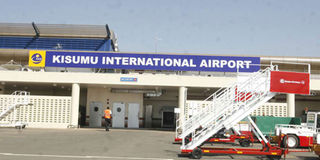Premium
Bird strike menace to cost agency Sh1 billion

Kisumu International Airport. FILE PHOTO | NMG
What you need to know:
- KAA plans to spend close to Sh1 billion to curb bird strike menace.
The Kenya Airports Authority (KAA) plans to spend close to Sh1 billion to curb bird strike menace, which has been blamed for emergency landings that have cost airlines billions of shillings in engine damages.
The initiative, to be initially installed at the country’s three premier airports, is intended to bar the feathered creatures, which at times use the same flight paths and levels as planes.
The authority’s head of wildlife control unit, Mr George Amutete, said the plan would be rolled out at Kisumu International Airport, Jomo Kenyatta International Airport and Mombasa’s Moi International Airport.
“We have an ambitious plan to acquire bird strike avoidance radar that, if installed, can help visualise birds as far as five nautical miles away and warn pilots in advance, or for the staff to take appropriate control measures,” he told the Sunday Nation.
He said the system would be able to reduce engine-associated damages from the current 33 per cent to five per cent.
While Wajir Airport is also riddled with the challenge of bird strikes due to the nearby slaughterhouse and poor sanitary conditions, installation of the gadget has not been prioritised due to low traffic and financial constraints.
According to International Civil Aviation Organisation (ICAO), 30 per cent of the damage of aircraft engine operational life is caused by foreign objects such as birds and stones.
The proposal is likely to be implemented in the next financial year after the National Treasury pushed forward the plan to improve the overall aviation safety in the country.
Through the new technology, he said, the authority will be able to control the strikes, which happen outside the airside and out of vision of wildlife control staff.
The KAA official who spoke on the sidelines of a two-day wildlife hazard management symposium held in Kisumu reiterated their commitment to safeguard airport operations. “We have to attain high standards of operations and safety in our airports to maintain Kenya’s status as a regional hub,” he said.
KAA statistics indicate that Kisumu International Airport has the highest chances of experiencing bird strikes, at 19.8 per 10,000 aircraft, as compared with the average of four bird strikes per every 10,000 aircraft movements since July 2018 to April 2019.




